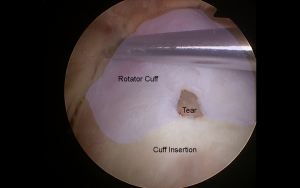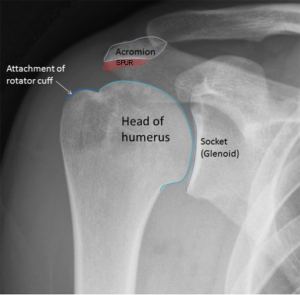ROTATOR CUFF DISEASE
Rotator cuff disease is a common problem in those approaching their 50s, 60s and beyond. Often rotator cuff tears are associated with impingement pain, resulting in weakness when raising the arm. In more advanced cases pain at night may be a problem causing trouble while sleeping on the affected side.
ANATOMY
The shoulder is a ball and socket joint. The ball is large and the socket is small. In many ways the size and shape of the shoulder joint are not dissimilar to a golf ball sitting on a golf tee. In order to stabilize this ball-on-socket design, an array of 4 muscles and their tendon cloak the ball, arising from the wing bone. These muscles, help stabilize the head of the shoulder and assist in powering the shoulder in all directions. Above the ball and socket there is a lubricating fluid sac called the bursa.
ROTATOR CUFF TEARING
In some cases tearing of the rotator cuff is simply a degenerative, time related problem. Much like the elbows on a jacket slowly wearing out the tissue that the rotator cuff is made from can fray and tear over time. What isn’t 100% clear is why some tears are painful while others are not. Of the four tendons which make up the rotator cuff, the most commonly torn is the supraspinatous.
Burstitis is the inflammation of the fluid filled sac above the shoulder joint. This may also be associated with a bony spur which often forms above the shoulder joint on the end of the acromion.
TREATMENT
Non-Surgical
Physiotherapy can be extremely helpful for rotator cuff tears. By strengthening the muscles of the rotator cuff and the anterior deltoid much of the pain associated with these tears can settle down resulting in improved function.
Steroid injections can help to settle down the pain of bursitis. Used as one or tow doses this can be very helpful, however excessive use can cause further tendon damage.
Surgical Treatment
The aim of this surgery is to reattach the torn and frayed tendons of the rotator cuff back to the top of the shoulder. This is achieved with special bone anchors and keyhole instruments.
Keyhole surgery for rotator cuff repair has some advantages over traditional open or mini open approaches.
• Less pain
• Shorter hospital stay (day case or overnight only)
• Lower chance of infection
• Faster initial rehabilitation
• Less stiffness (restriction of movement) following the surgery
• Better ability to identify and treat other areas of damage
On some occasions it may be necessary to perform a mini-open incision to accurately repair large tears.


